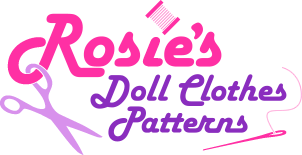After releasing my 3 Way Skirt Doll Clothes Pattern for 18 Inch American Girl and Cabbage Patch a little while ago, I’ve received a number of emails asking me about the different types of pleats. The two main types of pleats used when making doll clothes are the ‘knife’ and ‘box’ pleats. There are variances of these two – casual knife pleat, deep knife pleat, inverted box pleat, etc – but if you understand how to make these two simple pleats, then you will have no problems working with and creating pleats in your doll clothes. As you all know, I love to ‘show’ you how to do something, rather than write lengthy explanations and drawing umpteen diagrams, so I have put together a video showing you how to create these simple pleats and take the mystery out of pleating. Enjoy!
For lots more tips and tricks that make sewing doll clothes so much more fun try my How to Make Doll Clothes video course today.
Happy Sewing
![]()
By Rosie Saw


Rosie, you’ve done it again. Thank you for showing a great and easy way to make pleats. Like all of your teaching videos, you take the confusion out of so many patterns. Thank you for such great tips.
Hi Rosie, Just a question, if you are making a pleated skirt how do you guage how much fabric to use? If you are going to pleat just the back. ie a kilt.
Hi Helen, that’s a great question. Generally each pleat will have 3 layers and the length required will depend on whether you have additional distance (gaps) between the pleats or not. If you are doing a knife or box pleat all the way along the fabric with no additional gaps and you want the finished length to be 5″ you would need to multiply by 3 plus seam allowance so you would need 15 1/2″ if using 1/4″ seam allowance.
If you are doing a box pleat and have an additional gap in between each pleat it becomes a bit trickier because it depends on the size of the gap and the size of the pleat. I would suggest you practice with a piece of paper making the pleats the size you want with the gaps that you want and continue pleating until you are at the length you need for your project. Then when you unfold the paper, add your seam allowance and you have the length you require. I would also suggest you allow a little extra that you can trim off after folding your pleats just in case the pleats are not all exactly the same size – it is better to have too much fabric than not enough.
Happy sewing
Rosie
Thank you Rosie, the video demonstration makes the instruction very clear and easy to follow. Cheers and Happy Sewing.
My pleasure Ann and Cherrylmaree, glad you liked the video.
Thanks for the pleat tutorial, Rosie. I have done kilts for children and dolls and believe me, it was a nightmare. Wish I had this information a year ago. Oh well, better late than never. I will definitely have an easier time of it the next time I make a pleated skirt.
I will try your pleated skirt pattern real soon.
Thanks again and cheers,
Peggy
just a question~~do you hem the bottom before you do the pleats?
Hi Lynn, yes make sure to hem and add any trims you want before doing the pleats.
Happy sewing,
Rosie
Hi Rosie, will ironing the pleats at the pinned stage keep them in shape? or do they lose their shape over time? Do you ever sew along the line of each pleat to enhance its shape?
Hi Ruth, ironing the pleats at the pinned stage may permanently keep the pleats, it depends on the type of fabric that you are using. Different types of fabric hold pleats better than others and I believe that 100% polyester is best for holding pleats. Yes, you can certainly sew along the line of each pleat to enhance its shape and you can also sew part way down the pleat through the multiple layers. This will result in pleats only at the bottom part of the skirt. Have fun pleating 🙂
Very clear video! Thanks so much for making it, it’s the best one I have seen.
My pleasure Susan, have fun pleating. 🙂